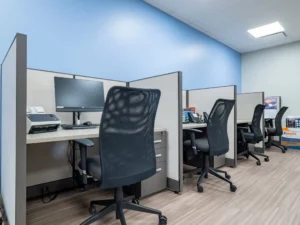You know that when your employees slouch at their desks for eight hours a day that it has negative effects on both their comfort and their productivity. This doesn’t have to be a foregone conclusion, however. You have options. In fact, there are many ways to integrate more comfortable and healthy workstation choices into your office space. Finding workstation harmony with ergonomic chairs that promote healthy posture and that are properly proportionate to well-appointed desks can help bolster employee comfort as it staves off the repetitive motion injuries that are common to modern offices.
Getting Your Workstations Right
If your employees spend long hours at their workstations – and most do – it’s critical that you provide them with office furniture that suits their needs. Well-designed workstations promote healthy posture and allow employees to appropriately adjust the height and configuration of their chairs and desktops. The desk chair, including the angle of the seat and the positioning of the footrest, are important for both comfort and healthy circulation. When it comes to getting your workstations right, there’s a lot to consider, but office furniture professionals, like those at InterWork, have the experience and knowhow to help you find what’s right for you.
The Right Office Chair
Simply rolling old office chairs into your employees’ cubicles isn’t a great approach for running a comfortable and productive office. Ideally, the chairs you provide your employees should be extremely sturdy and have plenty of adjustability built into them. There are several important considerations when it comes to choosing the right office chairs:
- Chair backs that hit at least as high as the shoulder blades are most supportive. Employees should sit against the chairs’ backs with a forward angle of about 110 degrees, which ensures adequate back support and good circulation.
- The edge of a chair’s seat should hit approximately three inches behind the back of its occupant’s knees, and the occupant’s feet should rest comfortably flat on the floor. Your employees’ knees should remain slightly lower than their hips.
- A chair’s arm positioning can help prevent repetitive motion injuries and bolster overall comfort throughout the workday. Optimally, the armrests should be positioned to support the occupant’s arms as they naturally hang from the shoulders and gently slope downward toward the keyboard. When so positioned, armrests can help ward off neck and upper back strain.
If You’re Experiencing Workstation Woes, Call InterWork for More Information
The right workstations can help your employees work both more comfortably and productively. Determining what’s right for your office and your employees doesn’t have to be daunting – the office furniture specialists at InterWork are here to help. We have 30 years of experience helping employers like you reimagine their workspaces by investing in office furniture that meets their employees’ needs. For expert help updating your workstations, give us a call at 800-821-3522 or send us an email through our online contact form today.





